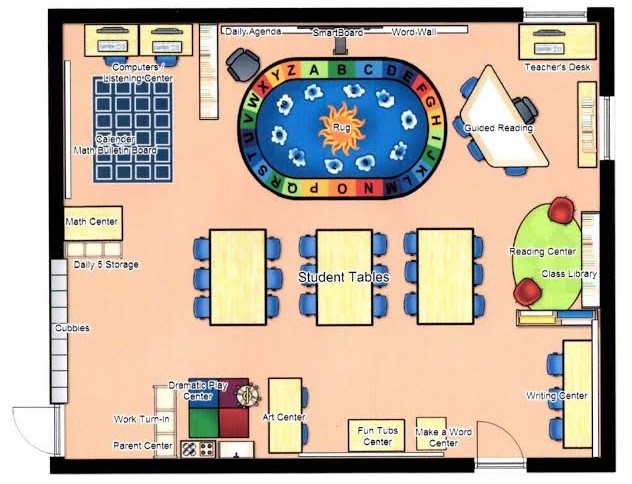Designing the actual layout of a Classroom
Designing the actual layout of a classroom includes organizing its spaces, furniture, and materials to maximize the learning opportunities and the engagement of each learner. When dealing with preschool learners (in this case, 4-year-olds), the classroom environment should be friendly to encourage them to enjoy their activities in class. In my view, a cluster sitting arrangement is appropriate to ensure learners interact among themselves fully and provide an opportunity to have an excellent view for all the students. This arrangement should comprise a round table and chairs surrounding it. In between, there should be walkways to allow movement with ease. This arrangement also allows the learners to brainstorm, collaborate with fellow learners, and easily ask questions (Shepherd & Linn, 2014). Shelves of considerable height should be adjacent to each group where learners can store their books and supplies. Similarly, boxes and bins should be close to where each group is situated for easy access, while the teacher’s desk should be at the back.
There should be areas set aside for various activities around the classroom such as the reading center, writing center, make a word center, fun tubs center, art center, dramatic center, math center, and computer center. The class library should be located next to the reading center to facilitate easier access. There should be a work turn-in area for learners to submit their assignments once they finish. All these areas should be labeled clearly for easy identification.
The classroom walls should be painted light blue color since it is considered desirable for learning. The floor should be covered with a carpet to provide warm touch for the learners. The carpet is soft, making it ideal for learners to sit on and prevent injury when they fall. A sink should be positioned strategically next to the wall and away from the learning area.
The board and visuals should be at the eye level of learners to help them understand the day’s and week’s schedules and routines. The classroom rules should be mounted on the walls where all learners can easily refer from time to time. The materials should be in strategic positions to ensure proper visibility. Moreover, window shades should remain open all through to allow natural light. LED lights can also be incorporated as an alternative for natural light. The last indicator is that the learners should be far from the door to minimize distraction due to regular opening and closing.
The figure below shows the layout of the classroom floor plan.

Teaching Style
Preschool teachers are often entitled to teach children their eating habits, reading aptitudes, toilet propensities, and cognitive skills. Several learning styles can be incorporated to ensure maximum classroom management. The coaching style that is mainly teacher-centered will help maintain authority in the classroom. This will involve demonstrating a particular concept while the learners closely observe and engage in class activities. Later on, the learners will be expected to follow the same procedure by themselves. The learners can seek guidance whenever they face a challenge when working by themselves. This style can be applied when learners work individually or as a group. When working individually, the teacher can tailor the particular needs of a learner and guide them appropriately. When working as a group, learners share ideas and often communicate to ensure that they follow the teacher’s instruction closely to obtain the desired result.
Since learners are arranged in a cluster position, delegation style can be easily applied. This teaching style is student-centered, thus allowing the learners to work as a group and share ideas. This will encourage communication and collaboration among learners. The teacher is entrusted with keenly observing the learners as they work to offer support guidance and maintain authority in the class, thus reducing disturbance instances. Each group can be assigned a particular task different from the others to concentrate on their work without consulting other groups fully. At times, all the groups can be given similar tasks to proceed to the next task when a particular group finishes.
Interactions
Classroom interaction increases learners’ inspiration, self-confidence, and self-esteem when they engage in classroom discussion and activities. I would advocate for both student-student interaction and teacher-student interaction in my classroom. The cluster sitting arrangement is appropriate for both interactions methods (Shepherd & Linn, 2014). Student-student interaction in a classroom allows learners to listen to one another, observe others as they work, and create a good rapport since it occurs naturally. This mode of interaction will also give the learners a chance to discuss and brainstorm different ideas. Learners can learn from their peers on new concepts, develop their methods of understanding particular concepts, develop problem-solving skills and enhance their literacy knowledge. Students who engage in this mode of interaction register impressive academic achievements.
Teachers should cultivate positive relationships with their students by making classroom environments more conducive for learning and meeting students’ developmental, emotional and scholarly needs. Teacher-student interaction will help to facilitate emotional support, classroom organization, and instructional support. Offering emotional support helps build steady connections, and learners enjoy learning. When the teacher organizes a classroom, the student learns to regulate their behavior and remain focused. Positive teacher-student relationships will help establish a conducive environment where the teachers and learners will have mutual respect. Instructors can effectively support students’ cognitive advancement and dialect development by offering instructional support. By ensuring healthy relationships in the classroom, learners with low self-esteem learn to react positively to the teacher’s reinforcement, hence building a sense of pride. The presence of positive teacher-student interactions ensures a complete focus on education free from disturbance, thus creating a thriving classroom.
Reference
Shepherd, T. L., & Linn, D. (2014). Behavior and classroom management in the multicultural classroom. SAGE
